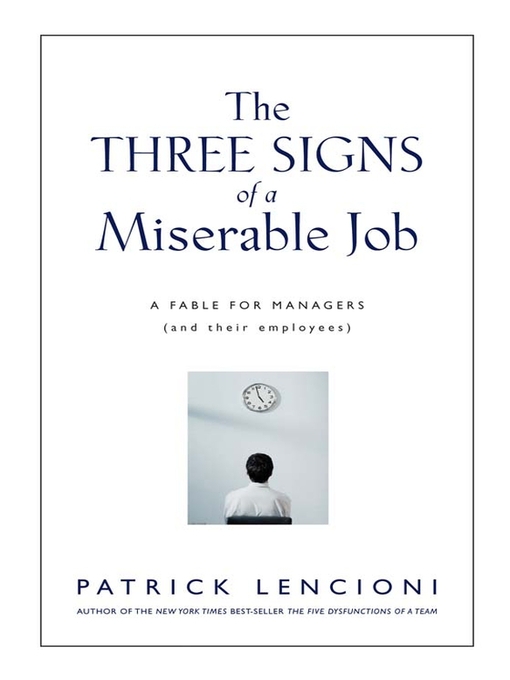
The Three Signs of a Miserable Job
A Fable for Managers (And Their Employees)
کتاب های مرتبط
- اطلاعات
- نقد و بررسی
- دیدگاه کاربران
نقد و بررسی

July 30, 2007
Lencioni, a consultant, speaker and bestselling author (The Five Dysfunctions of a Team), pinpoints the reasons behind and ways around what many consider a constant of the human condition: job dissatisfaction. According to Lencioni, job-fueled misery can ultimately seep into all aspects of life, leading to drug and alcohol abuse, violence and other problems, making this examination of job misery dynamics a worthy pursuit. Through the "simple" tale of a retired CEO-turned-pizzeria manager, Lencioni reveals the three corners of the employee unhappiness pyramid-immeasurability, anonymity and irrelevance-and how they contribute to dissatisfaction in all jobs and at all levels (including famously unfulfilled celebrities and athletes). The main culprit is the distancing of people from each other (anonymity), which means less exposure to the impact their work has (immeasurability), and thus a diminished sense of their own utility (irrelevance). While his major points could have been communicated more efficiently in a straightforward self-help fashion, his fictional case study proves an involving vessel for his model and strategies (applicable to managers and lower-level staff alike), and an appendix-like final chapter provides a helpfully stripped-down version.

July 30, 2007
Lencioni, a consultant, speaker and bestselling author (The Five Dysfunctions of a Team), pinpoints the reasons behind and ways around what many consider a constant of the human condition: job dissatisfaction. According to Lencioni, job-fueled misery can ultimately seep into all aspects of life, leading to drug and alcohol abuse, violence and other problems, making this examination of job misery dynamics a worthy pursuit. Through the "simple" tale of a retired CEO-turned-pizzeria manager, Lencioni reveals the three corners of the employee unhappiness pyramid-immeasurability, anonymity and irrelevance-and how they contribute to dissatisfaction in all jobs and at all levels (including famously unfulfilled celebrities and athletes). The main culprit is the distancing of people from each other (anonymity), which means less exposure to the impact their work has (immeasurability), and thus a diminished sense of their own utility (irrelevance). While his major points could have been communicated more efficiently in a straightforward self-help fashion, his fictional case study proves an involving vessel for his model and strategies (applicable to managers and lower-level staff alike), and an appendix-like final chapter provides a helpfully stripped-down version.
Copyright 2007 Library Journal, LLC Used with permission.

September 1, 2007
Anyone whos been employedwhether self- or by an organizationwill recognize the onset of the Sunday blues, which, in essence, is the dread of Monday at work. Lencioni, author of The Five Dysfunctions of a Team (2002), spins yet another fable. He tracks Brian Bailey through CEO-ship of JMJ Fitness, a much-abbreviated semi-retirement and two turnarounds. The lesson? That three qualities add up to misery at work: immeasurability, irrelevance, and anonymity. Simple in its telling, these three negative characteristics have been validated by any number of human-resources consultants, from Gallup to Watson Wyatt. People need to feel like theyre contributing to a greater good, that theyre valued and respected within the organization, and that what they do matters. Although the author has no specific process to follow or particular techniques to promote, he does paint a few hypothetical situationsand summarize questions that must be answered. Nothings new under the sun, yet Lencionis new expression of an old truth does deserve publicity.(Reprinted with permission of Booklist, copyright 2007, American Library Association.)

























دیدگاه کاربران